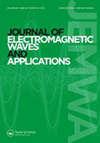用漫反射反分析估计NIR-SWIR吸收染料的介电响应函数
IF 1.1
4区 工程技术
Q4 ENGINEERING, ELECTRICAL & ELECTRONIC
Journal of Electromagnetic Waves and Applications
Pub Date : 2023-10-11
DOI:10.1080/09205071.2023.2260381
引用次数: 1
摘要
摘要本文利用漫反射反分析方法估计了NIR-SWIR吸收染料的介电响应函数。反分析过程基于Kramers-Kronig关系、漫反射的Kubelka-Munk模型和衬底光谱的背景相减。计算的响应函数提供了NIR-SWIR吸收染料的介电响应特性的估计,以及它们对材料背景环境的敏感性。该研究表明,在给定合理的吸光度估计的情况下,可以采用Kramers-Kronig分析来计算介电函数的估计。具体来说,Kramers-Kronig分析提供了相对于由于反分析和光谱测量程序产生的频谱伪影的介电响应结构的滤波。这可以显著减少为实现NIR-SWIR染料和衬底组合所需的介电响应特性所需的实验。此外,这些计算的响应函数可以支持近似有效介质模型的构建,该模型能够估计染色织物的反射特征。关键词:漫反射参数化建模染色织物吸收光谱披露声明作者未报告潜在的利益冲突。该项目得到了美国国防部项目的支持。本文章由计算机程序翻译,如有差异,请以英文原文为准。
Estimation of dielectric response functions for NIR-SWIR absorbing dyes by inverse analysis of diffuse reflectance
AbstractThis study describes the estimation of dielectric response functions for NIR-SWIR absorbing dyes by inverse analysis of diffuse reflectance. The inverse analysis procedure is based on the Kramers–Kronig relations, the Kubelka–Munk model of diffuse reflectance, and the background subtraction of substrate spectra. The calculated response functions provide estimates of the dielectric response characteristics for NIR-SWIR absorbing dyes, as well as their sensitivity to material-background environments. This study demonstrates that Kramers–Kronig analysis can be adopted for calculating estimates of dielectric functions, given any reasonable estimate of absorbance. Specifically, that Kramers–Kronig analysis provides filtering of dielectric response structure with respect to spectrum artifacts due to inverse-analysis and spectroscopic-measurement procedures. This can significantly reduce the experimentation necessary to achieve desired dielectric response characteristics for NIR-SWIR dye and substrate combinations. Furthermore, these calculated response functions can support the construction of approximate effective medium models capable of estimating reflectance features for dyed fabrics.KEYWORDS: Diffuse reflectanceparametric modelingdyed fabricsabsorption spectra Disclosure statementNo potential conflict of interest was reported by the author(s).Additional informationFundingThis project was supported by US DoD programs.
求助全文
通过发布文献求助,成功后即可免费获取论文全文。
去求助
来源期刊
CiteScore
3.60
自引率
7.70%
发文量
116
审稿时长
3.3 months
期刊介绍:
Journal of Electromagnetic Waves and Applications covers all aspects of electromagnetic wave theory and its applications. It publishes original papers and review articles on new theories, methodologies, and computational techniques, as well as interpretations of both theoretical and experimental results.
The scope of this Journal remains broad and includes the following topics:
wave propagation theory
propagation in random media
waves in composites and amorphous materials
optical and millimeter wave techniques
fiber/waveguide optics
optical sensing
sub-micron structures
nano-optics and sub-wavelength effects
photonics and plasmonics
atmospherics and ionospheric effects on wave propagation
geophysical subsurface probing
remote sensing
inverse scattering
antenna theory and applications
fields and network theory
transients
radar measurements and applications
active experiments using space vehicles
electromagnetic compatibility and interferometry
medical applications and biological effects
ferrite devices
high power devices and systems
numerical methods
The aim of this Journal is to report recent advancements and modern developments in the electromagnetic science and new exciting applications covering the aforementioned fields.

 求助内容:
求助内容: 应助结果提醒方式:
应助结果提醒方式:


